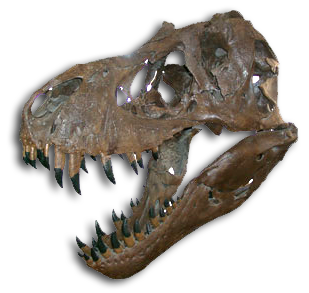Item Number
3057
Type
image
Description
Pterasaur Cast
Size
18
Age
Mesozoic, Late Jurassic
SciId
Pterodactylus antiguus
Status
in inventory
Display/Storage
Display
Building
Zuhl Museum
Original Site
Bavaria, Germany
Date Acquired
2014
Gallery/Room\Floor
History of Life Gallery
Notes
Solnhofen Limestone, 150 million years old, Pterodactylus antiguus was one of many species of extinct flying reptiles called "pterosaurs" that ruled the sky durin gthe Mesozoic Era. Although pterosaurs were not dinosaurs, they are closely related. Pterosaurs had hollow bones, large brains, well developed eyes, and greatly elongated finger on each forelimb which bore a flexicle wing membrane. Pterosaurs ranged from the size of a sparrow to the giant Quetzalcoatlus, whose wingspan was a large as a small plane, and may have been the largest flying animal that ever lived. Pterodactylus was a smller genus, about the size of a robin, with an 18 inch wingspan. It was one of the short-tailed species known as "pterodactyloids," which are thought to be descendants of a group of long-tailed pterosaurs known as "rhamphorynchoids." Paleontologists believe that most pterosaus were capable of powered flight, although the larger species may have soared on warm air currents for long time periods, much as birds of prey today. Pterosaus probably fed on fish, insects, and other small animals, although their diets probably varied from species to species. Fossil evidence indicates that pterosaurs along with dinosaurs went extinct at the end of the Cretaceous period, for reasons still being debated by scientists. Fortunately their fossilzed remains still being debated by scientists. Fortunately theri fossilzed remains allow scientists to reconstruct their apperance and prehistoric lifestyle. Occasionally a largely complete skeleton has been found, such as the cast specimen represetned here. It is one of the best preserved examples of this species, and includes several floating crinoids on the same plate. For more information see The Illustrated Encyclopedia of Pterosaurs, Peter Wellnhofer, 1991, Crescent Books, New York, NY).
Preview

Description
Solnhofen Limestone, 150 million years old, Pterodactylus antiguus was one of many species of extinct flying reptiles called "pterosaurs" that ruled the sky durin gthe Mesozoic Era. Although pterosaurs were not dinosaurs, they are closely related. Pterosaurs had hollow bones, large brains, well developed eyes, and greatly elongated finger on each forelimb which bore a flexicle wing membrane. Pterosaurs ranged from the size of a sparrow to the giant Quetzalcoatlus, whose wingspan was a large as a small plane, and may have been the largest flying animal that ever lived. Pterodactylus was a smller genus, about the size of a robin, with an 18 inch wingspan. It was one of the short-tailed species known as "pterodactyloids," which are thought to be descendants of a group of long-tailed pterosaurs known as "rhamphorynchoids." Paleontologists believe that most pterosaus were capable of powered flight, although the larger species may have soared on warm air currents for long time periods, much as birds of prey today. Pterosaus probably fed on fish, insects, and other small animals, although their diets probably varied from species to species. Fossil evidence indicates that pterosaurs along with dinosaurs went extinct at the end of the Cretaceous period, for reasons still being debated by scientists. Fortunately their fossilzed remains still being debated by scientists. Fortunately theri fossilzed remains allow scientists to reconstruct their apperance and prehistoric lifestyle. Occasionally a largely complete skeleton has been found, such as the cast specimen represetned here. It is one of the best preserved examples of this species, and includes several floating crinoids on the same plate. For more information see The Illustrated Encyclopedia of Pterosaurs, Peter Wellnhofer, 1991, Crescent Books, New York, NY). 8
Keywords
Pterasaur Cast Solnhofen Limestone, 150 million years old, Pterodactylus antiguus was one of many species of extinct flying reptiles called "pterosaurs" that ruled the sky durin gthe Mesozoic Era. Although pterosaurs were not dinosaurs, they are closely related. Pterosaurs had hollow bones, large brains, well developed eyes, and greatly elongated finger on each forelimb which bore a flexicle wing membrane. Pterosaurs ranged from the size of a sparrow to the giant Quetzalcoatlus, whose wingspan was a large as a small plane, and may have been the largest flying animal that ever lived. Pterodactylus was a smller genus, about the size of a robin, with an 18 inch wingspan. It was one of the short-tailed species known as "pterodactyloids, " which are thought to be descendants of a group of long-tailed pterosaurs known as "rhamphorynchoids." Paleontologists believe that most pterosaus were capable of powered flight, although the larger species may have soared on warm air currents for long time periods, much as birds of prey today. Pterosaus probably fed on fish, insects, and other small animals, although their diets probably varied from species to species. Fossil evidence indicates that pterosaurs along with dinosaurs went extinct at the end of the Cretaceous period, for reasons still being debated by scientists. Fortunately their fossilzed remains still being debated by scientists. Fortunately theri fossilzed remains allow scientists to reconstruct their apperance and prehistoric lifestyle. Occasionally a largely complete skeleton has been found, such as the cast specimen represetned here. It is one of the best preserved examples of this species, and includes several floating crinoids on the same plate. For more information see The Illustrated Encyclopedia of Pterosaurs, Peter Wellnhofer, 1991, Crescent Books, New York, NY). 2014 Mesozoic, Late Jurassic Fossil
Keywords
Pterasaur Cast Solnhofen Limestone, 150 million years old, Pterodactylus antiguus was one of many species of extinct flying reptiles called "pterosaurs" that ruled the sky durin gthe Mesozoic Era. Although pterosaurs were not dinosaurs, they are closely related. Pterosaurs had hollow bones, large brains, well developed eyes, and greatly elongated finger on each forelimb which bore a flexicle wing membrane. Pterosaurs ranged from the size of a sparrow to the giant Quetzalcoatlus, whose wingspan was a large as a small plane, and may have been the largest flying animal that ever lived. Pterodactylus was a smller genus, about the size of a robin, with an 18 inch wingspan. It was one of the short-tailed species known as "pterodactyloids, " which are thought to be descendants of a group of long-tailed pterosaurs known as "rhamphorynchoids." Paleontologists believe that most pterosaus were capable of powered flight, although the larger species may have soared on warm air currents for long time periods, much as birds of prey today. Pterosaus probably fed on fish, insects, and other small animals, although their diets probably varied from species to species. Fossil evidence indicates that pterosaurs along with dinosaurs went extinct at the end of the Cretaceous period, for reasons still being debated by scientists. Fortunately their fossilzed remains still being debated by scientists. Fortunately theri fossilzed remains allow scientists to reconstruct their apperance and prehistoric lifestyle. Occasionally a largely complete skeleton has been found, such as the cast specimen represetned here. It is one of the best preserved examples of this species, and includes several floating crinoids on the same plate. For more information see The Illustrated Encyclopedia of Pterosaurs, Peter Wellnhofer, 1991, Crescent Books, New York, NY). 2014 Mesozoic, Late Jurassic Fossil


